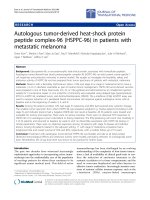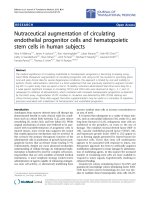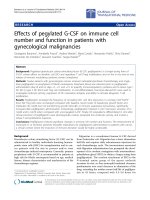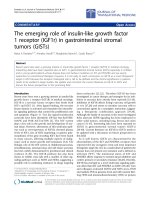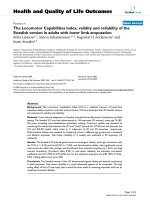báo cáo hóa học:" Epidural cement leakage through pedicle violation after balloon kyphoplasty causing paraparesis in osteoporotic vertebral compression fractures - a report of two cases" ppt
Bạn đang xem bản rút gọn của tài liệu. Xem và tải ngay bản đầy đủ của tài liệu tại đây (1.26 MB, 6 trang )
CAS E REP O R T Open Access
Epidural cement leakage through pedicle
violation after balloon kyphoplasty causing
paraparesis in osteoporotic vertebral compression
fractures - a report of two cases
Si-Young Park
1
, Hitesh N Modi
2*
, Seung-Woo Suh
2
, Jae-Young Hong
1
, Won Noh
2
, Jae-Hyuk Yang
1
Abstract
Kyphoplasty is advantageous over vertebroplasty in terms of better kyphosis correction and diminished risk of
cement extravasations. Literature described cement leakage causing neurological injury mainly after vertebroplasty
procedure; only a few case reports show cement leakage with kyphoplasty without neurological injury or proper
cause of leakage. We present a report two cases of osteoporotic vertebral compression fracture treated with
kyphoplasty and developed cement leakage causing significant neurological injury. In both cases CT scan was the
diagnostic tool to identify cause of cement leakage. CT scan exhibited violation of medial pedicle wall causing
cement leakage in the spinal canal. Both patients displayed clinical improvement after decompression surgery with
or without instrumentation. Retrospectively looking at stored fluoroscopic images, we found that improper position
of trocar in AP and lateral view simultaneou sly while taking entry caused pedicle wall violation. We suggest not to
cross medial pedicle wall in AP image throughout the entire procedure and keeping the trocar in the center of
pedicle in lateral image would be the most important precau tion to prevent such complication. Our case reports
adds the neurological complications with kyphoplasty procedure and suggested that along with other precautions
described in the literature, entry with trocar along the entire procedure keeping the oval shape of pedicle in mind
(under C-arm) will probably help to prevent such complications.
Introduction
Osteoporotic vertebral compression fracture (OVCF) is
the commonest complication of osteoporosis[1]. Over
the past two decades, vertebroplasty was developed to
stabilize OVCF without increasing morbidity and mor-
tality associated with open surgery[2,3]. Diamond and
colleagues. [4] noted that vertebroplasty for acute com-
pression fracture was significantly better than nonopera-
tive treatment in terms of pain relief, level of function,
and hospital stay. However, complications related with
vertebroplasty are not uncommon such as cement extra-
vasation, pulmonary embolism, infection, epidural hema-
toma, systemic toxicity, and vertebral body fractures
[5-17]. Among the commonest complications, cement
extravasation has be en estimated in 70% cases for ver-
tebroplasty procedures [18,19]. Most of the time it is
asymptomatic; however, disastrous complications caus-
ing paraparesis have been also reported in the literature
[10,15,19].
Kyphoplasty, as a modification of vertebroplasty, has
theoretical advantages such as focal kyphosis correction
and diminished risk of cement extravasation due to
lowe r cement injection pressur es [9,11,20- 22]. Backer et
al. [23] reported that out of 100 balloon kyphoplasties,
overall cement leakage rate was 31%. Most leakages
were anterior and superior; only 2% were posterior and
most leakages were below 3 mm. The biomechanical
principle of increasing anterior column load with pro-
gressing kyphosis leading to subsequent vertebral com-
pression fracture has established the basic rationale for
kyphoplasty [24]. Probably that is the reason for increas-
ing use of kyphoplasty procedures for OVCF now a day.
* Correspondence:
2
Scoliosis Research Institute, Department of Orthopedics, Korea University
Guro Hospital, Seoul, Korea
Full list of author information is available at the end of the article
Park et al. Journal of Orthopaedic Surgery and Research 2010, 5:54
/>© 2010 Park et al; licensee BioMed Central Ltd. This is an Open Access article distributed under the terms of the Creative Commons
Attribution License ( which permits unrestricted use, distribution, and reproductio n in
any medium, provid ed the original wor k is properly cited.
Even though kyphoplasty has significantly lower rates of
cement extravasations than vertebroplasty [21], cement
leakage may occur more frequently than originally
appreciated, and often associated with significant mor-
bidity [25]. There are numerous descriptions of signifi-
cant spinal cord or cauda equina injuries associated with
vertebroplasty procedures; however, only a few reports
have been described with kyphoplasty procedure [23].
Recently Patel et al. [26] reported 10 neurological com-
plications with kyphoplasty procedure in a multicenter
study, and suggested that physician should remain
aware about such complications. The purpose of our
case report was t o present two cases of epidural cement
leakage due to pedicle breakage causing significant neu-
rological damage after the kyphoplasty procedure. We
also aimed to address the reason caused pedicle rupture
in both cases while taking entry into p edicle which can
be prevented by simple care during procedure.
Case report
Case 1
An 88-year-old woman who was diagnosed with L3 and
L4 OVCF received balloon kyphoplasty using PMMA in
the neurosurgery department at local hospital. Two days
after the kyphoplasty, she was sent to our department
due to severe bilateral radicular pain in thigh and l egs,
with associated weakness and numbn ess in both lower
extremities. She was unable to walk after the procedure
which was in fact a new complaint after kyphoplasty.
Referring physician informed about difficulty while tak-
ing entry into both the pedicles at L3 and L4. The pro-
cedure was performed with uniportal entry into
pedicles. Examination revealed positive straight leg rais -
ing test in low er limbs, paresthesia and weakness in the
both thigh and leg (muscle power: Grade 3) below L3,
and restricted lumbar spine motion due to low back
pain. Roentgenographic images (Figure 1A-B) showed
the post procedure radiogram of lumbar spine which
could not reveal further information about complication.
Therefore she was investigated with CT scan (Figure
1C) which showed intracanal extension of cement from
L2-L4 and axial image exhibit significant compression of
cord at all three levels. Cement leakage was found from
medial pedicle wall of L3 (Figure 1C-E) which was
extended along the posterior longitudinal ligament at
L2-L4 levels causing severe compression of canal.
Surgical intervention was required to relieve the
intractable leg and back pain as well as neurologic defi -
cits. However, due to chronic renal failure and poor car-
diac function of patient, one-stage posterior approach
was performed without instrumentation: laminectomy of
L3-and L4 and partial laminectomy of L2 was performed
to achieve decompression of cord (Figure 2A-C). Com-
plete removal of cement was not tried. During operation
we could find the pedicle breakage from medial wall at
L3 from where cement was removed. Nerve root
decom pression was performed at L2-L4 levels bilaterally
and posterolateral fusion was achieved with local bone
mixed with allograft. The radiating pain was immedi-
ately relieved after surgery. Five days after surgery, back
pain was improved and motor weakness was recovered
up to grade 4 bilaterally. The patient was disch arged on
the tenth postoperative day after suture removal. Six
weeks after the operation, patient was able to walk
slowly with the help of walker wearing TLSO brace.
Muscle power in both the lower extremities was Grade
4 in thigh and legs. Still there was some paresthesia
remaining in her left lower extremity compared to right
on the latest follow-up.
Case 2
A 77-year-old woman, with a n L1 OVCF received bal-
loon kyphoplasty using PMMA at our hospital. Kypho-
plasty procedure w as performed through biportal entry.
Immediate after the procedure, her back pain was
improved; however, she complained severe radicular
pain in left thigh, with associated weakness and numb-
ness in left lower extremity. The patient was unable
bear weight on her left lower limb after the procedure;
and her knee joint had giving way sensation on walking.
Neurologic examination revealed a negative straight leg
raising test in lower limbs; however, paraesthesia and
weakness in the left thigh (muscle power: Grade 3)
below L1 was significant. Right lower extremity did not
reveal any positive neurological signs. Postprocedure
roentgenographic images (Figur e 3A-B) did not exhibit
extravasation of cement into the spinal canal at L1 level;
however, CT scan (Figure 3C-D) showed intracanal
extension of cement from medial wall violation of L1
pedicle on l eft side and causing significant c ompression
of cord. Retrospectively observing fluoroscopic images
during the procedure revealed that there was an incor-
rect positioning of trocar while taking entry into the
pedicle (Figure 4A-B); that further confirmed our suspi -
cion having pedicle wall violation.
Surgical intervention was performed using sin gle-stage
posterior approach: laminectomy of L1 was performed
to achieve decompression of cord ( Figure 5A-B) which
was followed by pedicle screw fixation from T12-L2.
Intraoperatively, we could observe epidural cement leak-
age from medial pedicle wall violation (Figure 5A).
Complete removal of cement mass of around 3.3 cm
size was done from left side (Figure 5B). Nerve root
decompression was performed bilaterally, and pedicle
screw instrumentation (Figure 5C-D) was done followed
by posterolateral fusion using local bone mixed with
allograft. The radiating leg pain was immediat ely
relieved after surgery. Three days after the surgery,
Park et al. Journal of Orthopaedic Surgery and Research 2010, 5:54
/>Page 2 of 6
motor weakness recovered up to grade 4 on left side
and paraesthesia was completely resolved. The patient
was discharged on the tenth postoperative day after
suture removal. Four weeks later patient was able to
walk freely wearing TLSO brace. Muscle p ower recov-
ered completely to Grade 5 at one month follow-up.
Discussion
Epidural cement leakage has only been described for
ver tebroplasty so far [6], but it has devastating neurolo-
gical effects in both vertebroplasty[ 10] and kyphoplasty
[26] procedures. These compli cations require immediate
surgic al interventions with decompr ession, and if possi-
ble, removal of the cement causing compression [23]. In
present report we have described two cases of epidural
cement leakage following balloon kyphoplasy which
caused significant neurological effects in both of them.
Simple care could possibly have avoided this complica-
tion intraoperatively which has not been described in
the literature.
Yeom et al. [27] described three different types of
cement leakages after percutaneous vertebroplasty such
as type B (via basivertebral vein), type S (via segmental
vein) and type C (via cortical defect). They used CT
scan to detect cement leakage; similarly, we have also
used CT scan to detect cement leakage. However, they
did not mention about leakage through pedicle wall.
Unfortunately, C-arm fluoroscopy is the only way to
monitor cement leakage during procedure. Furthermore,
leak could b e observed only in lateral not in AP view.
Therefore, identifying the leakage under C-arm is really
demanding in our opinion. Additionally it often difficult
to judge the cement leakage on simple radiogram as it
was seen in our case; and therefore, urgent CT scan
should be recommended if we suspect any kind of leak-
age. Becker et al. [23] reported a case of cement leakage
via pedicle wall perforation and mentioned oblique
images would have been helpful to detect the leakage
early. Nussbaum et al. [13] found that kyphoplasty may
have an increased risk of pedicle fracture that can lead
to spinal compression. They noted that at least five of
the 20 spinal compression associated with kyphoplasty
were caused by breakage of t he pedicle during insertion
of the cannula; and of the remaining 15 spinal compres-
sions that developed, only two specified that a pedicle
fracture was absent on postoperative imaging. Probably
Figure 1 (A -B) shows post kyphoplasty radiogram of lumbar spine which did not clarify any idea about cement leakage; figure (C-E)
shows that cement leakage spread along the posterior longitudinal ligament at L2-L4 levels causing severe compression of canal,
possibly through pedicle violation.
Park et al. Journal of Orthopaedic Surgery and Research 2010, 5:54
/>Page 3 of 6
this could be one of the reasons that all previously
described literatures with vertebroplasty have not men-
tioned this issue. As kyphoplasty is gaining popularity
for OVCF, cement leakage due to pedicle fracture needs
a special attention. In addition, risk to neurology cannot
be ignored during kyphoplasty procedure although the
literature mentioned low ri sk of cement leakage com-
pared to vertebroplasty procedure [21,25].
With proper surgical technique the risk of cement
leakage can be minimized. Greene et al. [28] popularized
eggshell-technique, in which, after primary reduction
with balloon a small amount of doughy cement is
applied into the cavity, followed by re-inflation of the
balloon. Their technique reported reduced risk of
cem ent leakage. Anselmetti et al. [29] show ed that high
viscosity bone cement has low rate of cement leakage
during vertebroplasty. However, in present both the
cases; we used high viscosity bone cement. Hu et al.
[30] suggested kyphoplasty via unipedicular approach to
reduce cement leakage along the cannula tract. In our
two cases, one patient (case 1) underwent kyphoplasty
with uni-pedicular approach; which suggested us that
there should be some technical problem which should
be discussed. Pateder et al. [31] mentioned technical tips
while taking entry into the pedicle and entering to the
vertebral body. They suggested that, when dr ill/trocar is
midway across the vertebral body in C-arm lateral view,
AP image should be obtained; and in AP view, drill/tro-
car should be midway between the pedicle and spinous
process at the same time. If it is closer to the spinous
process, there is a chance of entering in to the spinal
canal; similarly, if it is too close to the pedicle, it may be
out laterally. However, we feel that to judge distance
between spinous process and pedicle is difficult, and it
cannot be helpful in patient who had previous laminect-
omy. It is rather easy to observe the ov al pedicle shape
in C-arm to judge proper positioning of trocar. In first
case, history of difficulty while taking entry into the
Figure 2 (A -C) shows laminectomy of L3-and L4 and partial
laminectomy of L2 performed to achieve decompression of
cord without any instrumentation. Complete removal of cement
was not tried due to her health problem.
Figure 3 (A-B) shows post procedure radiogram of lumbar
spine which did not exhibit extravasation if cement into the
spinal canal at L1 level; figure 3 (C-D) shows CT scan of lumbar
spine that exhibited epidural extension of cement from medial
wall violation of L1 pedicle on left side and causing significant
compression of cord.
Figure 4 (A- B) shows fluoroscopic stored images during the
procedure which revealed that there was incorrect positioning
of trocar cannula while taking the entry into the pedicle
further confirming our suspicion of pedicle wall violation.
Park et al. Journal of Orthopaedic Surgery and Research 2010, 5:54
/>Page 4 of 6
pedicle with trocar probably gave us information about
pedicle violation. While in second case, observing the
stored images in C-arm, we found when trocar was just
posterior to the vertebral body in lateral view on left
side, it was situated more medially to the pedicle in AP
view; and that could be the reason for pedicle breakage
even though the procedure was uneventful. As reported
in literature [13], that kyphoplasty has higher chances of
pedicle fracture; our patient might have pedicle fracture
in subsequent procedure due medially located entry
point. Therefore, we recommend observing the pedicle
shape carefully while taking entry with trocar. Initially
trocar should be located on the lateral margin of pedicle
in AP view in the center and in middle of the pedicle in
lateral view. And when trocar reached to posterior bor-
der of vertebral body in lateral view, a gain AP view is
mandatory and trocar should not cross the middle of
the oval pedicle shape. In this way when trocar reached
up to anterior two-third of body (i.e. completion of
entry) in lateral view, it should not cross the medial wall
of pedicle in AP view.
In conclusion, due to high risk of pedicle fract ure inci-
dence during balloon kyphoplasty, risk of cement leakage
via pedicle violation causing significant morbidity cannot
be ignored. We have presented two cases with such com-
plications during balloon kyphoplasty which suggested
that alo ng with other precautions described in the litera-
ture, entry with trocar along the entire procedure keeping
the oval shape of pedicle in mind (under C-arm) w ill
probably help to prevent such complications.
Consent
Written informed consent was obtained from the patient
for publication of this case report and accompanying
images. A copy of the written consent is available for
review by the Editor-in-Chief of this journal.
Acknowledgements
No acknowledgements
Author details
1
Department of Spine Surgery, Orthopedic Department, Korea University
Anam Hospital, Seoul, Korea.
2
Scoliosis Research Institute, Department of
Orthopedics, Korea University Guro Hospital, Seoul, Korea.
Authors’ contributions
HNM has contributed in conception and design and acquisition of data,
analysis and interpretation of data, drafting the manuscript and revising it
critically, SYP has contributed in acquisition of data, revising the manuscript
critically and given the final approval, SWS has contributed in conception
Figure 5 A shows intraoperative image that showed epidural cement leakage from pedicle violation; figure 5B showed completely
removed cement mass of around 3.3 cm size and figure 5C-D shows postoperative radiogram of lumbar spine after decompression
and pedicle screw instrumentation followed by posterolateral fusion.
Park et al. Journal of Orthopaedic Surgery and Research 2010, 5:54
/>Page 5 of 6
and design of data, drafting the manuscript and given the final approval of
manuscript, JHY has contributed in analysis of data and drafting the
manuscript, WN has contributed in revising the manuscript, and JHY has
contributed in interpretation of data and final approval of manuscript. All
authors read and approved the final manuscript.
Competing interests
The authors declare that they have no competing interests. Each author
certifies that he has no commercial associations (e.g. consultancies, stock
ownership, equity interests, patent/licensing arrangements, etc) that might
pose a conflict of interest in connection with the submitted article.
Received: 19 February 2010 Accepted: 6 August 2010
Published: 6 August 2010
References
1. Kanis JA, Pitt FA: Epidemiology of osteoporosis. Bone 1992, 13(Suppl 1):
S7-15.
2. Gaitanis IN, Hadjipavlou AG, Katonis PG, Tzermiadianos MN, Pasku DS,
Patwardhan AG: Balloon kyphoplasty for the treatment of pathological
vertebral compressive fractures. Eur Spine J 2005, 14:250-260.
3. Lieberman IH, Dudeney S, Reinhardt MK, Bell G: Initial outcome and
efficacy of “kyphoplasty” in the treatment of painful osteoporotic
vertebral compression fractures. Spine (Phila Pa 1976) 2001, 26:1631-1638.
4. Diamond TH, Bryant C, Browne L, Clark WA: Clinical outcomes after acute
osteoporotic vertebral fractures: a 2-year non-randomised trial
comparing percutaneous vertebroplasty with conservative therapy. Med
J Aust 2006, 184:113-117.
5. Chen JK, Lee HM, Shih JT, Hung ST: Combined extraforaminal and
intradiscal cement leakage following percutaneous vertebroplasty. Spine
(Phila Pa 1976) 2007, 32:E358-362.
6. Chen YJ, Tan TS, Chen WH, Chen CC, Lee TS: Intradural cement leakage: a
devastatingly rare complication of vertebroplasty. Spine (Phila Pa 1976)
2006, 31:E379-382.
7. Choe DH, Marom EM, Ahrar K, Truong MT, Madewell JE: Pulmonary
embolism of polymethyl methacrylate during percutaneous
vertebroplasty and kyphoplasty. AJR Am J Roentgenol 2004, 183:1097-1102.
8. Coumans JV, Reinhardt MK, Lieberman IH: Kyphoplasty for vertebral
compression fractures: 1-year clinical outcomes from a prospective
study. J Neurosurg 2003, 99:44-50.
9. Garfin SR, Yuan HA, Reiley MA: New technologies in spine: kyphoplasty
and vertebroplasty for the treatment of painful osteoporotic
compression fractures. Spine (Phila Pa 1976) 2001, 26:1511-1515.
10. Lee BJ, Lee SR, Yoo TY: Paraplegia as a complication of percutaneous
vertebroplasty with polymethylmethacrylate: a case report. Spine (Phila
Pa 1976) 2002, 27:E419-422.
11. Lieberman I, Reinhardt MK: Vertebroplasty and kyphoplasty for osteolytic
vertebral collapse. Clin Orthop Relat Res 2003, S176-186.
12. Lin EP, Ekholm S, Hiwatashi A, Westesson PL: Vertebroplasty: cement
leakage into the disc increases the risk of new fracture of adjacent
vertebral body. AJNR Am J Neuroradiol 2004, 25:175-180.
13. Nussbaum DA, Gailloud P, Murphy K: A review of complications
associated with vertebroplasty and kyphoplasty as reported to the Food
and Drug Administration medical device related web site. J Vasc Interv
Radiol 2004, 15:1185-1192.
14. Schmidt R, Cakir B, Mattes T, Wegener M, Puhl W, Richter M:
Cement
leakage during vertebroplasty: an underestimated problem? Eur Spine J
2005, 14:466-473.
15. Tsai TT, Chen WJ, Lai PL, Chen LH, Niu CC, Fu TS, Wong CB:
Polymethylmethacrylate cement dislodgment following percutaneous
vertebroplasty: a case report. Spine (Phila Pa 1976) 2003, 28:E457-460.
16. Yang HL, Zhao L, Liu J, Sanford CG Jr, Chen L, Tang T, Ebraheim NA:
Changes of pulmonary function for patients with osteoporotic vertebral
compression fractures after kyphoplasty. J Spinal Disord Tech 2007,
20:221-225.
17. Zoarski GH, Snow P, Olan WJ, Stallmeyer MJ, Dick BW, Hebel JR, De
Deyne M: Percutaneous vertebroplasty for osteoporotic compression
fractures: quantitative prospective evaluation of long-term outcomes.
J Vasc Interv Radiol 2002, 13:139-148.
18. Cotten A, Dewatre F, Cortet B, Assaker R, Leblond D, Duquesnoy B,
Chastanet P, Clarisse J: Percutaneous vertebroplasty for osteolytic
metastases and myeloma: effects of the percentage of lesion filling and
the leakage of methyl methacrylate at clinical follow-up. Radiology 1996,
200:525-530.
19. Hadjipavlou AG, Tzermiadianos MN, Katonis PG, Szpalski M: Percutaneous
vertebroplasty and balloon kyphoplasty for the treatment of
osteoporotic vertebral compression fractures and osteolytic tumours. J
Bone Joint Surg Br 2005, 87:1595-1604.
20. Grohs JG, Matzner M, Trieb K, Krepler P: Minimal invasive stabilization of
osteoporotic vertebral fractures: a prospective nonrandomized
comparison of vertebroplasty and balloon kyphoplasty. J Spinal Disord
Tech 2005, 18:238-242.
21. Phillips FM, Todd Wetzel F, Lieberman I, Campbell-Hupp M: An in vivo
comparison of the potential for extravertebral cement leak after
vertebroplasty and kyphoplasty. Spine (Phila Pa 1976) 2002, 27:2173-2178,
discussion 2178-2179.
22. Voggenreiter G: Balloon kyphoplasty is effective in deformity correction
of osteoporotic vertebral compression fractures. Spine (Phila Pa 1976)
2005, 30:2806-2812.
23. Becker S, Meissner J, Tuschel A, Chavanne A, Ogon M: Cement leakage
into the posterior spinal canal during balloon kyphoplasty: a case report.
J Orthop Surg (Hong Kong) 2007, 15:222-225.
24. Robinson Y, Tschoke SK, Stahel PF, Kayser R, Heyde CE: Complications and
safety aspects of kyphoplasty for osteoporotic vertebral fractures: a
prospective follow-up study in 102 consecutive patients. Patient Saf Surg
2008, 2:2.
25. Hulme PA, Krebs J, Ferguson SJ, Berlemann U: Vertebroplasty and
kyphoplasty: a systematic review of 69 clinical studies. Spine (Phila Pa
1976) 2006, 31:1983-2001.
26. Patel AA, Vaccaro AR, Martyak GG, Harrop JS, Albert TJ, Ludwig SC,
Youssef JA, Gelb DE, Mathews HH, Chapman JR, et al: Neurologic deficit
following percutaneous vertebral stabilization. Spine (Phila Pa 1976) 2007,
32:1728-1734.
27. Yeom JS, Kim WJ, Choy WS, Lee CK, Chang BS, Kang JW: Leakage of
cement in percutaneous transpedicular vertebroplasty for painful
osteoporotic compression fractures. J Bone Joint Surg Br 2003, 85:83-89.
28. Greene DL, Isaac R, Neuwirth M, Bitan FD: The eggshell technique for
prevention of cement leakage during kyphoplasty. J Spinal Disord Tech
2007, 20:229-232.
29. Anselmetti GC, Zoarski G, Manca A, Masala S, Eminefendic H, Russo F,
Regge D: Percutaneous vertebroplasty and bone cement leakage: clinical
experience with a new high-viscosity bone cement and delivery system
for vertebral augmentation in benign and malignant compression
fractures. Cardiovasc Intervent Radiol 2008, 31:937-947.
30. Hu MM, Eskey CJ, Tong SC, Nogueira RG, Pomerantz SR, Rabinov JD,
Pryor JC, Hirsch JA: Kyphoplasty for vertebral compression fracture via a
uni-pedicular approach. Pain Physician 2005, 8:363-367.
31. Pateder DB, Khanna AJ, Lieberman IH: Vertebroplasty and kyphoplasty for
the management of osteoporotic vertebral compression fractures.
Orthop Clin North Am 2007, 38:409-418, abstract vii.
doi:10.1186/1749-799X-5-54
Cite this article as: Park et al.: Epidural cement leakage through pedicle
violation after balloon kyphoplasty causing paraparesis in osteoporotic
vertebral compression fractures - a report of two cases. Journal of
Orthopaedic Surgery and Research 2010 5:54.
Submit your next manuscript to BioMed Central
and take full advantage of:
• Convenient online submission
• Thorough peer review
• No space constraints or color figure charges
• Immediate publication on acceptance
• Inclusion in PubMed, CAS, Scopus and Google Scholar
• Research which is freely available for redistribution
Submit your manuscript at
www.biomedcentral.com/submit
Park et al. Journal of Orthopaedic Surgery and Research 2010, 5:54
/>Page 6 of 6




